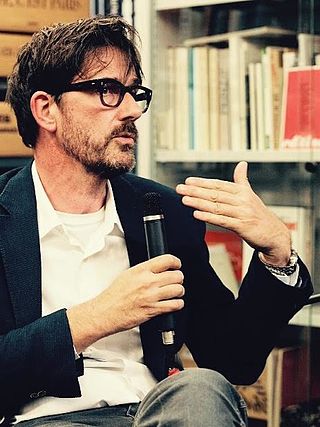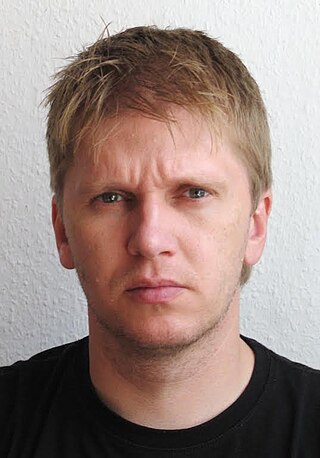
Hans Josephsohn was a Swiss sculptor who lived and worked in Zurich.
Museums of modern art listed alphabetically by country.
Matthias Weischer is a German painter living in Leipzig. He is considered to be part of the New Leipzig School.

Norbert Bisky is a German artist based in Berlin. He is one of the most important representatives of a new figurative painting in the 21st century.
Michael Buthe was a German artist who lived and worked between Germany and Morocco. He exhibited widely throughout Europe during his life and is known for his eclectic and prolific oeuvre which encompasses painting, sculpture, and installation.

Markus Vater is a German artist. He studied at the Kunstakademie Düsseldorf and the Royal College of Art, London. From 2012 to 2016 he had been teaching at the Royal College of Art in London. In 2014 he had a guestprofessorship at the Hochschule für bildende Künste Hamburg and from 2016 to 2019 at the Staatliche Akademie der Bildenden Künste Karlsruhe. Currently he is teaching at the Hochschule der bildende Künste Essen. His studio is at Studio Voltaire. Vater lives in London and works in London and Essen.

Peter Dreher was a German artist and academic teacher. He painted series of landscapes, interiors, flowers and skulls, beginning his series Tag um Tag guter Tag in 1974. As a professor of painting, he influenced artists including Anselm Kiefer. His works have been exhibited internationally.
Florian Hecker is a German sound and visual artist. Born in 1975 in Augsburg, Germany and raised in Kissing, Germany Hecker studied Computational Linguistics and Psycholinguistics at Ludwig Maximilian Universität, Munich and Fine Arts at the Akademie der Bildenden Künste, Vienna, where he received his diploma in 2003. He lives and works in Vienna and Kissing, Germany.
Klaus Peter Brehmer, was a German painter, graphic artist and filmmaker. From 1971 to 1997 he was professor at the Hochschule für bildende Künste Hamburg.

Michael Elmgreen and Ingar Dragset have worked together as an artist duo since 1995. Their work explores the relationship between art, architecture and design.

Rainer Fetting is a German painter and sculptor.
Helmut Federle is a Swiss painter.

Peter Zizka is a German designer and conceptual artist.
Florian Pumhösl is a contemporary artist based in Vienna, mainly known for his works that employ abstract visual language to reflect on the diverse manifestations of modernity. His interests include "historical formal vocabulary of modernism," and "the genealogical derivation of a particular form" and its sociopolitical setting. His work has been described as being "between the two poles of formalism and historicity." Often taking the form of a series, his works span a wide range of media, including films, installations, objects, and glass paintings.

Roman Ondak is a Slovak conceptual artist.
Norbert Prangenberg was an abstract painter, sculptor, and engraver who was born in Nettseheim, just outside of Cologne, Germany. Though he had no formal training and did not fully engage with art until his 30s, Prangenberg did finally come up with a style that was uniquely his own, not fitting comfortably into the neo-expressionist or neo-geo movements of his time, in the 1970s and 1980s. At this time, he was considered a major figure in contemporary German art. Though he got his start with abstract paintings, he also became known for making sculptures of all sizes; and while his work initially appears abstract, the titles given sometimes allude to the human body or a landscape. As a trained gold- and silversmith, as well as a glassblower, he always showed an attention to materials and how they could be physically engaged with. He was interested in how his own two hands could affect the painting or sculpture's surface. Traces of the artist's hand appear literally throughout his entire oeuvre, before he lost the battle with liver cancer in 2012.

Wiebke Siem is a German mixed media artist of German and Polish heritage, winner of the prestigious Goslarer Kaiserring in 2014 as "one of the most innovative and original artists who has never compromised in their art and whose sculptures have a tremendous aura and presence because they mix the familiar and the unfamiliar, the known and the unknown".
Christoph Girardet is a German filmmaker and artist. He lives and works in Hanover.








